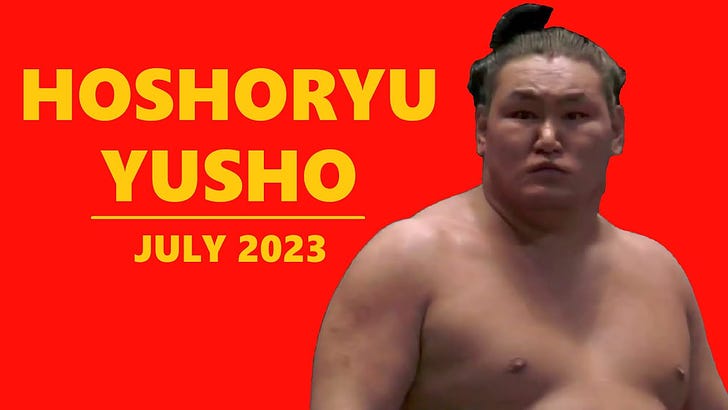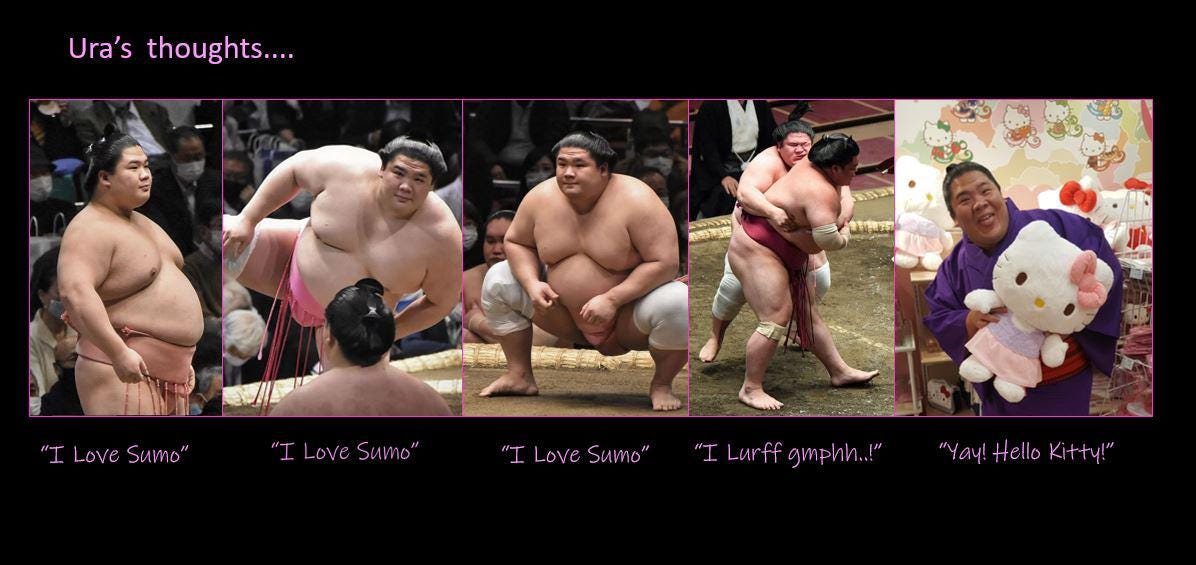We still have several weeks to go until the next Grand Sumo tournament, so let me quickly analyze the last tournament! I’m using the Sumo Database as my data source.
In my May tournament wrap-up, I looked at the uniqueness of moves, because I wanted to award my man Ura a prize for uniqueness.
Alas, I can’t really do that this time:
As a reminder, I’m simply counting the number of unique winning moves each wrestler had during the tournament.
Hoshoryu Review: Dominant and Versatile
Obviously, the maximum number each could get is their number of wins — and as tournament winner, Hoshoryu had 13 wins (I’m also counting his playoff with Hokutofuji). Hokutofuji came in second with 12 wins.
Here are the 9 unique kimarite (winning moves) that Hoshoryu used:
If you want to see those winning moves in action, Full 15 Sumo compiled the matches from Abema:
The strangest-looking one is on day 5 with Abi, okurihikiotoshi — called a rear pull-down. It’s a rarely-used kimarite.
In fact, according to the sumo database, this is the only time Hoshoryu has used it, and it’s used as a winning move only 0.02% of the time.
Okurihikiotoshi Demo Video:
Interlude: Sumo Training with English Captions
This is from ex-pro sumo wrestler Gagamaru’s YouTube channel. He visits the stable where former ozeki Asanoyama trains.
This shows traditional sumo training, and assumes not much knowledge. So there are explanations of some of the exercises you are seeing, like the teppo pole.
Overall Review of Winning Moves Used
Let’s look at the moves used by division:
Makuuchi is the highest sumo division, Jonidan is the lowest. These are the categories of kimarite (winning moves).
Unsurprisingly, the kihonwaza category, which includes basic moves like oshidashi and yorikiri, are used most often and are used even more at the lowest levels.
Interestingly, the usage of hinerite (twisty moves) decreased in July for Makuuchi compared to May. Tokushuwaza increased — these are “special” techniques, and notice that the top two divisions use special techniques more often than lower divisions.
Here is the May graph so you can compare:
Specific Techniques Comparison
One last graph, and then we’ll go:
Yorikiri (frontal force out) and oshidashi (frontal push out) are the most common moves, and the difference is whether the winner has hands on the loser’s mawashi (belt).
Yorikiri - do have hands on the belt; oshidashi - don’t.
Basically, you’re getting the other guy out of the ring while you’re face-to-face for both. But notice that the highest level is more often yorikiri than oshidashi.
Hatakikomi is slap-down, and this one is one of the many outcomes of a henka or similar dodge at the beginning of the match. If you’ve ever seen a one-second match, this is usually hatakikomi — notice it’s higher in the higher divisions.
Tsukiotoshi is thrust down, and one of the “twisty” techniques. You often see this one when a wrestler is on the edge of the ring, about to be pushed out, and then he twists and pushes the other guy down and out. A lot of the guys up in Makuuchi are masters of this technique.
Finally, yoritaoshi is frontal crush out. I think the reason this is low for Makuuchi is that this can happen when the winner is going for a yorikiri and the other guy tries to hang on to the ring’s edge and falls over. At the higher levels, wrestlers who know they’re going to lose will allow the yorikiri rather than risk getting injured from a crush out. (That’s my theory, at any rate…. maybe I need to analyze how wrestlers lose next…)









